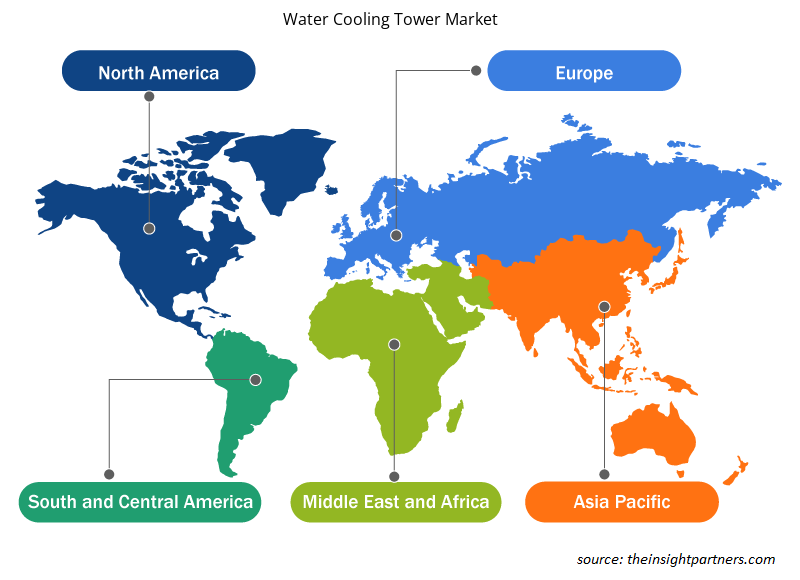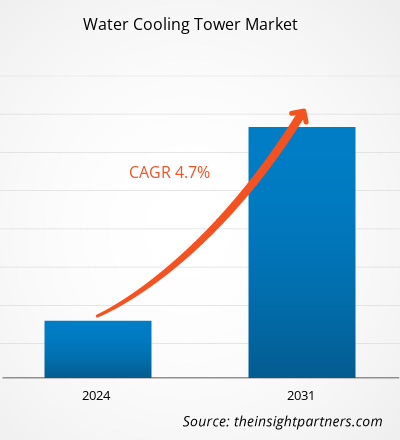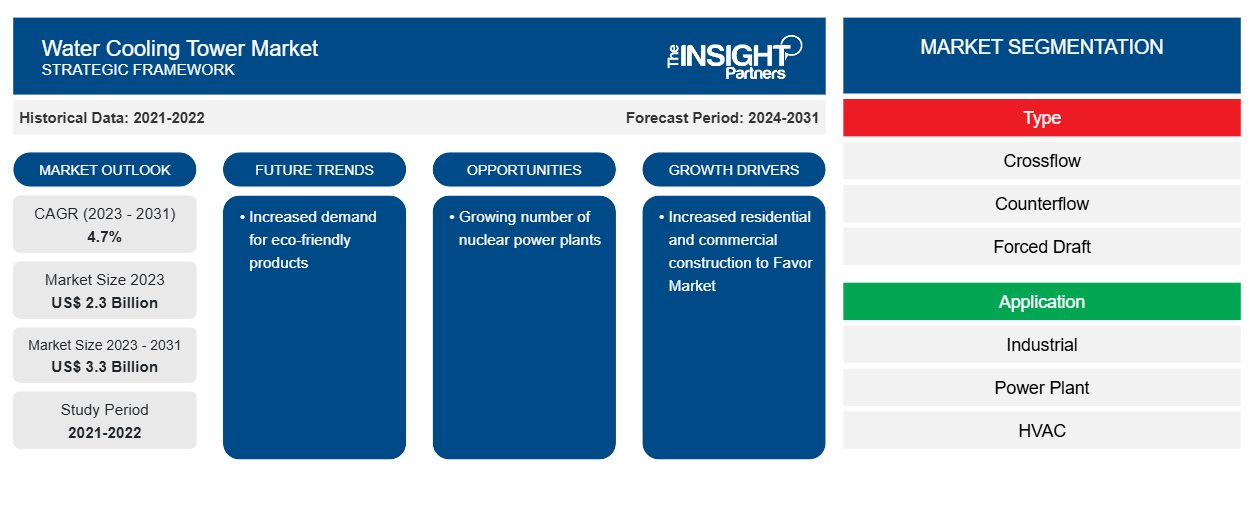Si prevede che la dimensione del mercato delle torri di raffreddamento dell'acqua raggiungerà i 3,3 miliardi di dollari entro il 2031, rispetto ai 2,3 miliardi di dollari del 2023. Si prevede che il mercato registrerà un CAGR del 4,7% nel periodo 2023-2031. Con le crescenti preoccupazioni sulla sostenibilità e sulla riduzione dell'impronta di carbonio, la domanda di prodotti eco-compatibili per il raffreddamento delle torri dell'acqua è aumentata. Pertanto, è probabile che una maggiore sostenibilità rimanga una tendenza chiave nel mercato.
Analisi di mercato delle torri di raffreddamento ad acqua
La domanda di torri di raffreddamento ad acqua è aumentata nel settore energetico. Poiché la domanda di energia è in crescita, la spesa per la costruzione di centrali elettriche e, quindi, il numero complessivo di centrali elettriche è aumentato negli ultimi anni. Ad esempio, secondo i dati pubblicati dal governo degli Stati Uniti, il paese si sta concentrando sulla costruzione del 55% in più di centrali elettriche nel 2024 rispetto al 2023. Tale spesa per la costruzione nel settore energetico sta guidando la domanda per il mercato delle torri di raffreddamento ad acqua.
Panoramica del mercato delle torri di raffreddamento ad acqua
Nel 2023, il Nord America ha rappresentato una quota di mercato notevole del mercato globale delle torri di raffreddamento ad acqua. Paesi come gli Stati Uniti e il Canada sono leader del mercato nordamericano delle torri di raffreddamento ad acqua. Uno dei fattori che sta guidando il mercato è la forte crescita industriale. I data center richiedono un forte sistema di raffreddamento per mantenere l'efficienza operativa. Pertanto, molti dei data center sono installati con torri di raffreddamento per mantenere la temperatura. Le torri di raffreddamento nei data center utilizzano aria e acqua per trasferire il calore dei data center. Questi sistemi di raffreddamento hanno una maggiore efficienza rispetto ai tradizionali metodi di raffreddamento ad aria , costi operativi inferiori e flessibilità. Secondo i dati di Cloudscene, gli Stati Uniti hanno circa 5400 data center negli Stati Uniti. Pertanto, a causa della presenza di un vasto numero di data center, la domanda di torri di raffreddamento ad acqua è aumentata negli ultimi anni.
Personalizza questo report in base alle tue esigenze
Riceverai la personalizzazione gratuita di qualsiasi report, comprese parti di questo report, o analisi a livello nazionale, pacchetto dati Excel, oltre a usufruire di grandi offerte e sconti per start-up e università
-
Scopri le principali tendenze di mercato in questo rapporto.Questo campione GRATUITO includerà analisi di dati che spaziano dalle tendenze di mercato alle stime e alle previsioni.
Driver e opportunità del mercato delle torri di raffreddamento ad acqua
Aumento delle costruzioni residenziali e commerciali per favorire il mercato
Le costruzioni commerciali e residenziali stanno crescendo rapidamente a causa della significativa urbanizzazione e industrializzazione. Circa oltre il 93% degli edifici totali sono costruzioni residenziali e commerciali; inoltre, circa l'85% dei piedi quadrati totali degli edifici sono dedicati alle costruzioni residenziali e commerciali. Con una penetrazione così elevata delle costruzioni residenziali e commerciali, la domanda di sistemi HVAC è aumentata, guidando in ultima analisi il mercato delle torri di raffreddamento ad acqua.HVAC systems has increased, ultimately driving the water cooling tower market.
Crescente numero di centrali nucleari
Poiché la richiesta di energia è in aumento, la domanda di centrali nucleari è in aumento. Inoltre, a causa della maggiore consapevolezza delle emissioni di carbonio, l'attenzione sulle centrali nucleari è aumentata poiché sono più efficienti ed efficaci. Secondo i dati pubblicati dal Nuclear Energy Institute, negli Stati Uniti, circa 471 milioni di tonnellate di carbonio vengono evitate utilizzando centrali nucleari. Inoltre, ad oggi, le fonti di energia nucleare contribuiscono al 10% dell'elettricità mondiale. Quindi, i governi di tutto il mondo stanno aumentando il contributo delle centrali nucleari costruendone di più. Ad esempio, secondo i dati pubblicati dalla World Nuclear Association, ci sono 60 centrali nucleari in costruzione . Quindi, si prevede che l'aumento della domanda di centrali nucleari genererà notevoli opportunità di entrate nei prossimi anni.
Analisi della segmentazione del rapporto di mercato delle torri di raffreddamento dell'acqua
I segmenti chiave che hanno contribuito alla derivazione dell'analisi di mercato delle torri di raffreddamento ad acqua sono tipologia e applicazione.
- In base al tipo, il mercato delle torri di raffreddamento ad acqua è suddiviso in flusso incrociato, controflusso, tiraggio forzato, tiraggio indotto e altri. Il segmento a flusso incrociato ha detenuto una quota di mercato maggiore nel 2023.
- Per applicazione, il mercato è segmentato in industriale, centrale elettrica e HVAC. Il segmento industriale ha detenuto una quota notevole del mercato nel 2023.
Analisi della quota di mercato delle torri di raffreddamento dell'acqua per area geografica
L'ambito geografico del rapporto di mercato sulle torri di raffreddamento ad acqua è suddiviso principalmente in cinque regioni: Nord America, Asia Pacifico, Europa, Medio Oriente e Africa, Sud e Centro America.
L'Asia Pacifica deteneva la quota di mercato dominante nel mercato globale delle torri di raffreddamento ad acqua. Paesi come Cina, India, Indonesia e Filippine stanno crescendo notevolmente. Tale crescita sta portando a una maggiore domanda di energia poiché il settore industriale sta crescendo rapidamente. Inoltre, a causa dell'urbanizzazione, la domanda per i settori residenziale e commerciale è aumentata. Con tale crescita nei settori dell'edilizia, industriale ed energetico, la domanda di sistemi di raffreddamento convenienti è aumentata, guidando in ultima analisi il mercato delle torri di raffreddamento ad acqua.
Approfondimenti regionali sul mercato delle torri di raffreddamento dell'acqua
Le tendenze regionali e i fattori che influenzano il mercato delle torri di raffreddamento ad acqua durante il periodo di previsione sono stati ampiamente spiegati dagli analisti di Insight Partners. Questa sezione discute anche i segmenti e la geografia del mercato delle torri di raffreddamento ad acqua in Nord America, Europa, Asia Pacifico, Medio Oriente e Africa e America meridionale e centrale.

- Ottieni i dati specifici regionali per il mercato delle torri di raffreddamento ad acqua
Ambito del rapporto di mercato sulle torri di raffreddamento dell'acqua
| Attributo del report | Dettagli |
|---|---|
| Dimensioni del mercato nel 2023 | 2,3 miliardi di dollari USA |
| Dimensioni del mercato entro il 2031 | 3,3 miliardi di dollari USA |
| CAGR globale (2023-2031) | 4,7% |
| Dati storici | 2021-2022 |
| Periodo di previsione | 2024-2031 |
| Segmenti coperti |
Per tipo
|
| Regioni e Paesi coperti |
America del Nord
|
| Leader di mercato e profili aziendali chiave |
|
Densità degli attori del mercato: comprendere il suo impatto sulle dinamiche aziendali
Il mercato delle torri di raffreddamento ad acqua sta crescendo rapidamente, spinto dalla crescente domanda degli utenti finali dovuta a fattori quali l'evoluzione delle preferenze dei consumatori, i progressi tecnologici e una maggiore consapevolezza dei vantaggi del prodotto. Con l'aumento della domanda, le aziende stanno ampliando le loro offerte, innovando per soddisfare le esigenze dei consumatori e capitalizzando sulle tendenze emergenti, il che alimenta ulteriormente la crescita del mercato.
La densità degli operatori di mercato si riferisce alla distribuzione di aziende o società che operano in un particolare mercato o settore. Indica quanti concorrenti (operatori di mercato) sono presenti in un dato spazio di mercato in relazione alle sue dimensioni o al valore di mercato totale.
Le principali aziende che operano nel mercato delle torri di raffreddamento dell'acqua sono:
- Imprese Babcock e Wilcox
- Inc.
- Azienda Aircoil di Baltimora
- Torri di raffreddamento a campana
- Torri di raffreddamento Delta
- Inc.
Disclaimer : le aziende elencate sopra non sono classificate secondo un ordine particolare.

- Ottieni una panoramica dei principali attori del mercato delle torri di raffreddamento ad acqua
Notizie di mercato e sviluppi recenti sulle torri di raffreddamento dell'acqua
Il mercato delle torri di raffreddamento ad acqua viene valutato raccogliendo dati qualitativi e quantitativi dopo la ricerca primaria e secondaria, che include importanti pubblicazioni aziendali, dati associativi e database. Di seguito sono elencati alcuni degli sviluppi nel mercato delle torri di raffreddamento ad acqua:
- Baltimore Aircoil Company (BAC) annuncia il lancio del suo nuovo TrilliumSeries Adiabatic Cooler. Questo raffreddatore adiabatico è ideale per applicazioni che richiedono una combinazione di efficienza energetica e un uso limitato di acqua. Il design innovativo di BAC massimizza sia l'efficienza idrica che quella energetica, riducendo al minimo i costi. Inoltre, il TrilliumSeries Cooler è progettato per semplificare l'installazione e la manutenzione continua. (Fonte: Baltimore Aircoil Company, comunicato stampa, febbraio 2022)
- Tower Tech, il principale produttore di torri di raffreddamento, è orgoglioso di annunciare la sua linea di torri di raffreddamento dotate della tecnologia StormStrong Fiber Reinforced Polymer (FRP) resistente alla corrosione. Le torri di raffreddamento StormStrong sono in grado di gestire venti di uragano, terremoti e sollecitazioni meteorologiche con danni minimi o nulli. (Fonte: Tower Tech, comunicato stampa, settembre 2022)
Copertura e risultati del rapporto sul mercato delle torri di raffreddamento ad acqua
Il rapporto "Dimensioni e previsioni del mercato delle torri di raffreddamento ad acqua (2021-2031)" fornisce un'analisi dettagliata del mercato che copre le seguenti aree:
- Dimensioni e previsioni del mercato delle torri di raffreddamento ad acqua a livello globale, regionale e nazionale per tutti i segmenti di mercato chiave coperti dall'ambito
- Tendenze del mercato delle torri di raffreddamento dell'acqua e dinamiche di mercato come driver, vincoli e opportunità chiave
- Analisi PEST e SWOT dettagliate
- Analisi di mercato delle torri di raffreddamento ad acqua che copre le principali tendenze del mercato, il quadro globale e regionale, i principali attori, le normative e i recenti sviluppi del mercato
- Analisi del panorama industriale e della concorrenza che copre la concentrazione del mercato, l'analisi della mappa di calore, i principali attori e gli sviluppi recenti nel mercato delle torri di raffreddamento ad acqua
- Profili aziendali dettagliati
- Analisi storica (2 anni), anno base, previsione (7 anni) con CAGR
- Analisi PEST e SWOT
- Valore/volume delle dimensioni del mercato - Globale, Regionale, Nazionale
- Industria e panorama competitivo
- Set di dati Excel
Report recenti
Rapporti correlati
Testimonianze
Motivo dell'acquisto
- Processo decisionale informato
- Comprensione delle dinamiche di mercato
- Analisi competitiva
- Analisi dei clienti
- Previsioni di mercato
- Mitigazione del rischio
- Pianificazione strategica
- Giustificazione degli investimenti
- Identificazione dei mercati emergenti
- Miglioramento delle strategie di marketing
- Aumento dell'efficienza operativa
- Allineamento alle tendenze normative























 Ottieni un campione gratuito per - Mercato delle torri di raffreddamento dell'acqua
Ottieni un campione gratuito per - Mercato delle torri di raffreddamento dell'acqua